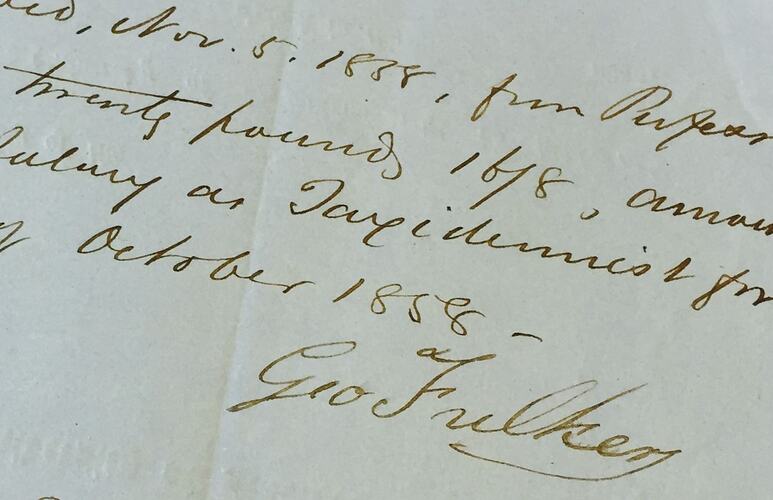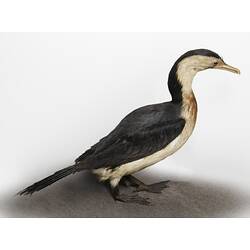George Fulker was born in London, England, about1805/1806. During the 1830s, Fulker lived in Marylebone, London, where he was a boot- and shoe-maker, and where he married Christiana in 1833. Seeking to escape the economic depression in London during this period, George and Christiana successfully applied to the Free Passage to South Australia migration scheme which ran from 1836-1841. They embarked from London in February 1840 on the 'Orleana' and arrived in Adelaide in June 1840. George was aged about 35 years when he arrived, and was soon running his own business as a boot-maker and bird-stuffer from a succession of shops in Hindley Street, Adelaide circa 1843-1851. George is reported to have met natural historian William Blandowski (1822-1876) while in Adelaide. George's movements from 1851-1853 are unclear, but it is likely that he packed up in Adelaide, and joined the exodus of thousands of South Australians in the rush to the Victorian goldfields.
Fulker subsequently arrived in Melbourne in 1853, and resumed his business in boot-making and natural history, this time from a shop in Great George Street, Collingwood from about January-March 1853. Blandowski arrived in Melbourne in March-April 1853, after selling up his mining operations in the Central Victorian goldfields, in order to resume his natural history work. The two men are presumed to have met up again in Melbourne.
The Museum of Natural History (predecessor to Museum Victoria) was established in March 1854, in the same building as the Assay Office and Surveyor-General's Office in Latrobe Street, with Blandowski appointed as the first Curator (and Colonial Zoologist). Fulker, then aged 48-49 years, was the Museum's second employee, officially commencing work in November 1854 as the Taxidermist. However he is thought to have started work for Blandowski on a casual basis some months earlier, preparing specimens collected during Blandowski's first expedition to Central Victoria which ran from June-September 1854, in readiness for the Museum's display at the Melbourne Exhibition held at the Exhibition Building in William Street from October-December 1854. The work by the two men, who were the only two official Museum employees at the time, earned the Museum a Silver Medal.
Fulker remained behind, working at the Museum, whilst Blandowski was away in the field on his first expedition and also on his second expedition to the Mornington Peninsula and Western Port in November 1854-March 1855. He worked to build up the collections and displays again, after the Museum's contribution for the 1854 Melbourne Exhibition had been shipped off to the 1855 Paris Exposition. As with Blandowski, Fulker's specialty was likely to have been birds, although he could also turn his hand to mammals and other groups. In the first year of operation for the Museum (April 1854-April 1855), an estimated 320 birds and 45 mammals from Victoria were 'stuffed and mounted'.
Fulker remained with Blandowski working at the old museum site at the Assay Office, after Frederick McCoy (circa 1823-1899) orchestrated his controversial takeover of the Public Museum and the transfer of all the collections to a new home at the University of Melbourne in Carlton in July 1856. Eventually Fulker was forced to transfer over as well and report for work with McCoy at the new Public Museum, and the close working relationship between himself and Blandowski was disrupted. Fulker was the only Museum employee to work at both the Assay Office and the University. Fulker was set to work in an 'atelier' in the first floor of the north wing of the Quadrangle Building housing the Museum, until McCoy's growing displays and expanding museum scheme overwhelmed the available space, and he was forced to relocate his workspace to the underground cellars and basement.
Fulker missed out on accompanying Blandowski on his third expedition for the Surveyor-General and the Victorian Government to the junction of the Lower Murray and Darling rivers from December 1856-December 1857. Blandowski was forced to go without a trained Taxidermist. However Fulker did eventually get to work on parts of this collection after they were consigned back to the Public Museum at the University. He was likely responsible for stuffing and setting-up a series of about 50 mammals, sorted out by the expedition naturalist Gerard Krefft (1830-1881) while working for McCoy in February 1858. Fulker is also reported to have done private work for Blandowski on other parts of the collection which had been secretly retained at Blandowski's city apartment.
The working relationship between Fulker and McCoy deteriorated during 1858, particularly as McCoy became aware of Fulker's continuing association and allegiance with Blandowski. Fulker fell out of favour as McCoy's efforts turned from acquiring local Victorian collections to purchasing major overseas collections. Fulker was further sidelined as McCoy engaged John Leadbeater (1831-1888) as Second Taxidermist in May 1858 and entrusted him to prepare the important bird and mammal collections arriving from English natural history suppliers such as John Gould (1804-1881) and John Gray (1800-1875) in 1858.
The flashpoint came in December 1858, when McCoy ordered Fulker to process several large sharks which had been preserved in corrosive sublimate (a mercury-based solution), which were probably stored in the confined basement of the Museum in the Quadrangle. Fulker was possibly more used to working with vertebrate material that had been preserved with arsenical soap (arsenic-based), at the time considered a less toxic chemical, and he refused McCoy's orders to carry out work with an unfamiliar and more noxious preservative. McCoy took the opportunity to have Fulker dismissed at the end of December 1858, and he immediately instated Leadbeater as First Taxidermist. At the time, Fulker was aged about 52 years, and Leadbeater was 26 years (half his age). Fulker had the dubious honour of being the first employee to be fired from the Museum.
Fulker moved on, opening a new boot-making and taxidermy business in Lygon Street, Carlton in 1859, but he did not do any more work for McCoy or the Museum. Blandowski had already left Melbourne to return to Europe in March 1859, so there was no chance for Fulker to resume work with his old friend. Fulker had some success with his business, awarded an Honorable Mention medal for his cases of stuffed birds and fishes at the 1861 Victorian Exhibition (in connection with the 1862 London Exhibition).
Fulker retired from the business about 1876, after accumulating more than 30 years' experience in the craft of taxidermy (four years at the Museum from 1854-1858, and the rest with his own business). He was responsible for most of the taxidermy work in the first four years of operation at the Museum, setting up some of the earliest Victorian natural history collections, some of which are now unique examples of Victoria's now-extinct or endangered species.
In retirement, George and Christiana lived at several different home addresses in Carlton and Fitzroy. Details are unclear, but George appears to have died around 1882-1883, aged about 76-78 years. It would have been a ripe old age for a taxidermist at the time. Fulker was one of the Museum's behind-the-scenes workers, and not often recognised in the main Museum histories. His biographical details are scarce, and we are only beginning to fill in his life story and uncover his legacy in the Museum collections.
More Information
-
Keywords
-
Authors
-
Article types

